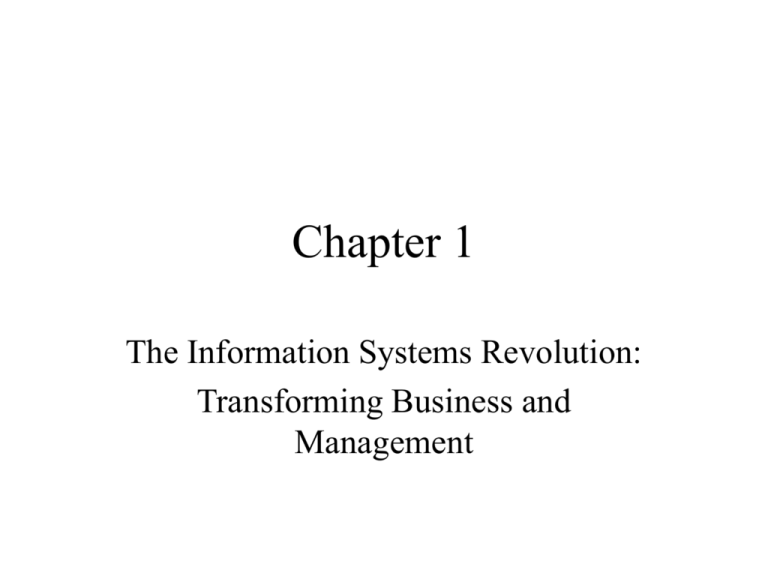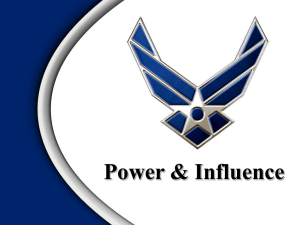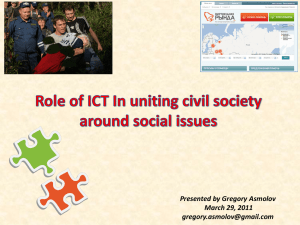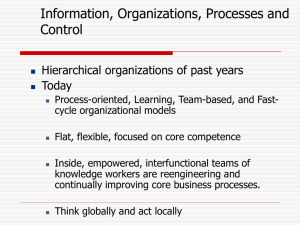The New Role of Information Systems in Organization
advertisement

Chapter 1 The Information Systems Revolution: Transforming Business and Management Why Information Systems? • The Competitive Business Environment – Three powerful worldwide changes have altered the environment of business. • Emergence of the global economy An increasing dependence on imports and exports is emerging. Today, information systems provide the communication and analytic power that firms need for conducting trade and managing businesses on a global scale. Globalization and IT bring new threats to local businesses. • Transformation of industrial economies Major leading economies are transforming to knowledge- and informationbased service economies. Information and knowledge intense products are becoming the foundation for many services & products. (cont.) 2 Chapter 1 Why Information Systems? • (cont.) Intensification of knowledge use in the traditional products is increased. More knowledge and information intense organizations have emerged. • Transformation of the business enterprise The traditional firm is still hierarchical, centralized, structured, and set of specialists, depend on rigid division of labor, formal rules and plans. The new style is more towards decent., flexible set of generalists to produce mass-customization products, depend on informal commitments and goals, flexible arrangement of teams, and customer orientation for task forces. – What is an Information System? • Information system is an interrelated components that collect, process, store, and distribute information to support decision making and control in an organization. (cont.) 3 Chapter 1 Why Information Systems? • They contain information about significant people, places, and things. Information means data that have been shaped into a form that is meaningful and useful to humans beings. Data are streams of raw facts representing events occurring in org. or physical environment before being in a form understandable to humans. • 3 activities in IS produce the information are input, output, and processing. – A Business Perspective on Information Systems • From a business perspective, an information system is an organizational and management solution, based on information technology, to a challenge posed by the environment. 4 Chapter 1 Why Information Systems? • Organization IS are parts of the org. The key elements of org. are people, structure and operating procedures, politics, and culture. • Management Managers perceive business challenges in the environment, set the organizational strategy for responding, and allocate the human and financial resources to achieve the strategy and coordinate the work. • Technology IT is a tool used by managers for coping with the change. 5 Chapter 1 Why Information Systems? • Contemporary Approaches to Information Systems – Technical Approach • Emphasizes mathematically based, normative models to study information systems, as well as the physical technology and formal capabilities of these systems. The disciplines are: computer science, management science, and operations research. – Behavioral Approach • It is important in IS field to be concerned with issues such as strategic business integration, design, implementation, utilization, and management need to be addressed using behavioral sciences: psychology, economics, and sociology. 6 Chapter 1 The New Role of Information Systems in Organization • The Widening Scope of Information Systems – Growing interdependence between business strategy, rules, and procedures on one side and information systems soft., hardware, databases, and telecommunications on the other. – 2nd change in relationship of information system and organizations results from the growing complexity and scope of system projects and applications. • The Network Revolution and the Internet – Information systems play important role because of soaring power and declining cost of computer technology. – The most widely used network is the Internet. – The Internet is extremely elastic. – It is creating new universal technology platform. It is reshaping the way IS can be used. 7 Chapter 1 The New Role of Information Systems in Organization – World Wide Web is a system with universally accepted standards for storing, retrieving, formatting, and displaying information. – All Web pages maintained by an organization or individual are called Web site. • New Options for Organizational Design: The Networked Enterprise – The growth in computing power and networks is turning organizations into networked enterprises. – This capability can be used to redesign organizations, transforming their structure, scope of operations, reporting and control mechanisms, work practices, work flows, products, and services. 8 Chapter 1 The New Role of Information Systems in Organization – Flattening Organizations • Large, bureaucratic organizations, which developed before the computer age, are often inefficient, slow to change, and less competitive. • Flatter organizations have fewer levels of management, with lower level employees being given greater decision-making authority. • More information available to line workers so they can make decisions previously made by managers. • The management span of control also been broadened. This means managers can manage and control more workers spread over greater distances. 9 Chapter 1 The New Role of Information Systems in Organization – Separating work from location • • • • It is possible now to organize globally while working locally. Many workers can work remotely from their homes or cars Collaborative teamwork across thousands of miles is a reality. Companies can coordinate their geographically distributed capabilities and coordinate with other organizations (virtual organization). – Reorganizing work flows 10 • Electronic work flows have reduced the cost of operations in many companies by displacing paper and the manual routines. • Improved work-flow management has enabled corporations to cut costs significantly and improve customer service. • Redesigned work flows have a profound impact on organizational efficiency. Chapter 1 The New Role of Information Systems in Organization – Increasing flexibility of organizations • Using communication technologies organize the company into more flexible ways, increase their ability to respond to changes, and take advantage of new opportunities. • Small organizations use IS to have the power of large companies. • Large organizations use information technology to achieve the responsiveness of small organizations (mass customization). – The changing management process • Information technology provides powerful new capabilities to help managers plan, organize, lead, and control. 11 Chapter 1 The New Role of Information Systems in Organization • Many companies now use IT for enterprise resource planning (ERP), which integrates all facets of the business, including planning, manufacturing, sales, and finance so they become closely coordinated. – Redefining organizational boundaries • Networked IS enable transactions to be exchanged electronically among different companies. • Systems linking a company to its customers, distributors, or suppliers are termed interorganizational systems. • Electronic Commerce and Electronic Business – The previous changes created new ways of conducting business 12 Chapter 1 The New Role of Information Systems in Organization – Electronic market is an information system that links together buyers and sellers to exchange information, products, services, and payments. – The are like middlemen to facilitate the transactions. – Vast array of goods and services are advertised, bought, and exchanged worldwide using Internet. – Web also increases the use of business-to-business transactions. 13 Chapter 1 The New Role of Information Systems in Organization – Electronic commerce is the process of buying and selling goods and services electronically. It also encompasses activities supporting those market transactions, such as advertising, marketing, customer support, delivery, and payment. It then accelerate all facets of business transactions while reducing operating and inventory costs. – Internet technology is being increasingly used to facilitate the management of the rest of the business (policies, account balances, production plans, scheduling plant maintenances, etc.). 14 Chapter 1 Learning to Use Information Systems: New Opportunities with Technology – Intranet is the internal network based on Internet and WWW technology and standards. – Electronic business is the use of the Internet and other digital technology for organizational communication and coordination and the management of the firm. It extends the reach of existing management (e-mail, web documents, work-groups soft., group scheduling, etc.). • IS today creates today many opportunities and also it is a source of problems, issues, and challenges for managers. 15 Chapter 1 The New Role of Information Systems in Organization – The strategic business challenge: The power of computation and communication has grown rapidly. To stay competitive, many organizations need to be redesigned. – The globalization challenge: International trade is a reality. Given lang., cultural, and political differences among countries, this focus resulted in a failure of central management control. Hence, global hardware, software are needed. 16 Chapter 1 The New Role of Information Systems in Organization – The information architecture challenge: The new technology rearranges social relations in the office and work locations, and changes reporting patterns, and therefore redesigns the organization. • New information architecture is the particular form information technology takes in an organization to achieve selected goals or functions. It is the specific design for the business application systems. • The platform for it is information technology infrastructure. It is the set of computer hardware, software, network, and human resources required to operate the equipment. • Even under best situations, combining the knowledge of different systems is a demanding task because of the incompatibility. 17 Chapter 1 The New Role of Information Systems in Organization – The information systems investment challenge: The challenging is not to use the technology and inexpensive computers but, however, management and organization. Is this investment pays off? Are we getting return as expected? Do competitors get more? – The responsibility and control challenge: The systems are essential for business if they are accurate, reliable and secure. It is disastrous if system deliver info in an interpretable form. Fraud, abuse and destruction chances are enormous. 18 Chapter 1











